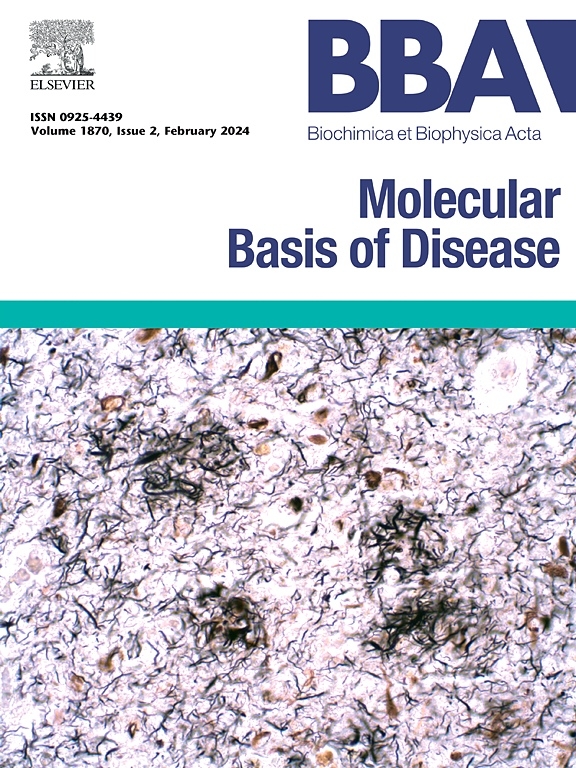Polyphyllin I inhibits glioblastoma progression by initiating ferroptosis via the Sirt1/Nrf2/HO-1/GPX4 signaling cascade
IF 4.2
2区 生物学
Q2 BIOCHEMISTRY & MOLECULAR BIOLOGY
Biochimica et biophysica acta. Molecular basis of disease
Pub Date : 2025-08-26
DOI:10.1016/j.bbadis.2025.168028
引用次数: 0
Abstract
Rationale
Glioblastoma is a fast-growing, invasive brain tumor with poor prognosis. Polyphyllin I, a saponin from Liliaceae plants, shows anti-tumor, anti-inflammatory effects, and induces ferroptosis, but its impact on glioblastoma and underlying mechanisms are not well understood.
Methods
Tumor malignancy was evaluated using assays such as scratch assays, CCK-8, clonogenic analyses, transwell experiments, along with EdU incorporation staining. Quantification for relevant molecules was performed using WB and RT-qPCR experiments. Ferroptosis in cells was quantified using JC-1, Boodipy, and TME assays. Lastly, the in vivo anti-tumor effects and mechanisms of Polyphyllin I were examined using a mouse xenograft model.
Results
This study reveals how PPI significantly inhibits GBM growth and spread while simultaneously improving the efficacy of chemotherapy drugs. In addition, the anti-tumor properties of PPI are linked to ferroptosis, and its effect is significantly diminished when ferroptosis is inhibited. Specifically, PPI binds directly to SIRT1, reducing its levels, which subsequently promotes oxidative cell death via the SIRT1/Nrf2/GPX4/HO-1 signaling pathway, thus suppressing glioblastoma. Furthermore, overexpression of SIRT1 can negate the therapeutic effects of PPI. The mouse xenograft model further supported the anti-tumor efficacy of PPI and provided deeper insights into its underlying mechanism.
Conclusions
Additionally, through regulating the SIRT1/Nrf2/GPX4/HO-1 axis, PPI induces iron-dependent cell death, contributing to its inhibition of glioblastoma. According to this research, PPI could serve as a superior treatment approach for GBM patients and holds promise for its combination with chemotherapy drugs in GBM treatment.
Polyphyllin I通过Sirt1/Nrf2/HO-1/GPX4信号级联启动铁凋亡,抑制胶质母细胞瘤的进展。
理由:胶质母细胞瘤是一种生长迅速的侵袭性脑肿瘤,预后差。从百合科植物中提取的茶多酚I具有抗肿瘤、抗炎和诱导铁下垂的作用,但其对胶质母细胞瘤的影响及其机制尚不清楚。方法:采用划痕试验、CCK-8、克隆分析、transwell实验、EdU结合染色等方法评价肿瘤的恶性程度。采用WB和RT-qPCR实验对相关分子进行定量分析。使用JC-1、Boodipy和TME测定细胞中的铁下垂。最后,利用小鼠异种移植瘤模型研究了聚茶树素1的体内抗肿瘤作用及其机制。结果:本研究揭示了PPI如何在显著抑制GBM生长和扩散的同时,提高化疗药物的疗效。此外,PPI的抗肿瘤特性与铁下垂有关,当铁下垂被抑制时,其作用显著减弱。具体来说,PPI直接与SIRT1结合,降低其水平,随后通过SIRT1/Nrf2/GPX4/HO-1信号通路促进氧化细胞死亡,从而抑制胶质母细胞瘤。此外,SIRT1的过表达可以抵消PPI的治疗效果。小鼠异种移植模型进一步支持了PPI的抗肿瘤功效,并为其潜在机制提供了更深入的见解。结论:此外,PPI通过调控SIRT1/Nrf2/GPX4/HO-1轴,诱导铁依赖性细胞死亡,参与抑制胶质母细胞瘤。根据本研究,PPI可以作为GBM患者的一种优越的治疗方法,并有望与化疗药物联合治疗GBM。
本文章由计算机程序翻译,如有差异,请以英文原文为准。
求助全文
约1分钟内获得全文
求助全文
来源期刊
CiteScore
12.30
自引率
0.00%
发文量
218
审稿时长
32 days
期刊介绍:
BBA Molecular Basis of Disease addresses the biochemistry and molecular genetics of disease processes and models of human disease. This journal covers aspects of aging, cancer, metabolic-, neurological-, and immunological-based disease. Manuscripts focused on using animal models to elucidate biochemical and mechanistic insight in each of these conditions, are particularly encouraged. Manuscripts should emphasize the underlying mechanisms of disease pathways and provide novel contributions to the understanding and/or treatment of these disorders. Highly descriptive and method development submissions may be declined without full review. The submission of uninvited reviews to BBA - Molecular Basis of Disease is strongly discouraged, and any such uninvited review should be accompanied by a coverletter outlining the compelling reasons why the review should be considered.

 求助内容:
求助内容: 应助结果提醒方式:
应助结果提醒方式:


